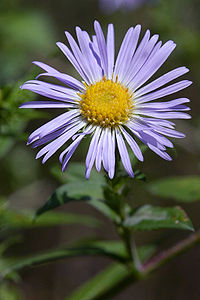Symphyotrichum novae-angliae
| Habit | herbaceous
| |
|---|---|---|
| Height: | ⇕ | 1 ft"ft" can not be assigned to a declared number type with value 1. to 5 ft"ft" can not be assigned to a declared number type with value 5. |
| Lifespan: | ⌛ | perennial |
| Bloom: | ❀ | late summer, early fall, mid fall, late fall |
| Exposure: | ☼ | sun |
|---|---|---|
| Water: | ◍ | moist |
| Features: | ✓ | flowers |
| USDA Zones: | 4 to 8.5 | |
| Flower features: | ❀ | yellow, blue, purple, white |
Symphyotrichum novae-angliae (formerly Aster novae-angliae), commonly known as the New England Aster, is an herbaceous perennial in the composite family.
The plant grows up to 120 cm with a stout, hairy stem and lance-shaped leaves with entire margins. The flower heads are showy with yellow disc florets at the center and ray florets that range from a deep purple or rose to rarely white. The New England aster inhabits a wide variety of habitats and soil types, though it does not tolerate strong shade.
Due to the attractive flowers, numerous cultivars of have been developed. Furthermore, as a result of its increased usage in the garden, it has been introduced to many area beyond its natural range, including Europe and several western US states.[1]
Read about Symphyotrichum novae-angliae in the Standard Cyclopedia of Horticulture
|
|---|
|
Aster novae-angliae, Linn. New England Aster. A stout-std. corymbosely branched perennial, 3-5 ft.: Lvs. oblong-lanceolate, clasping the st., hairy, 2½-4 in. long: fls. numerous, showy, the 40-50 violet- purple rays about ½-¾ in. long. E. N. Amer. A.F. 9:283.—The best and most widely known native aster suitable for open places but partial to moisture. Var. roseus, Hort., an excellent rose-colored form, is offered by some dealers. Many cult, forms in European collections.
|
Cultivation
Propagation
Pests and diseases
Varieties
Gallery
References
- ↑ Brouillet, Luc; Semple, John C.; Allen, Geraldine A.; Chambers, Kenton L.; Sundberg, Scott D. (2006). "Symphyotrichum novae-angliae". in Flora of North America Editorial Committee, eds. 1993+. Flora of North America. 20. New York & Oxford: Oxford University Press. pp. 487. http://www.efloras.org/florataxon.aspx?flora_id=1&taxon_id=250067662
- Standard Cyclopedia of Horticulture, by L. H. Bailey, MacMillan Co., 1963
External links
- w:Symphyotrichum novae-angliae. Some of the material on this page may be from Wikipedia, under the Creative Commons license.
- Symphyotrichum novae-angliae QR Code (Size 50, 100, 200, 500)

